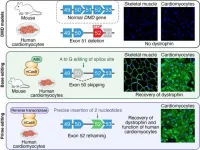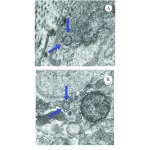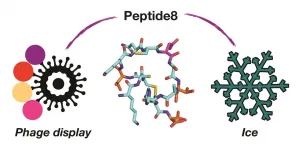INFORMATION:
These findings appear online in the journal Thorax.
Funding for this study was provided by the National Institutes of Health/National Heart, Lung, and Blood Institute (ROI HL095388 and ROI HL 118542-01) and Dutch Longfonds Foundation (4.2.16.132JO).
Note to editors:
GO reports unrelated personal fees from AstraZeneca and grants from Janssen Pharmaceuticals. PSH reports unrelated grants from Boehringer lngelheim and Galapagos. MvdB reports unrelated research grants from GlaxoSmithKline, TEVA Pharmaceuticals and Chiesi. AS reports unrelated founder's equity from Metera Pharmaceuticals as well as grants and personal fees from Janssen Research and Development. KS reports grants from CHEST Foundation, unrelated grants from Lungevity Foundation Early Detection Award and royalties from UpToDate. MEL reports unrelated founder's equity from Metera Pharmaceuticals and unrelated grants from Janssen Research and Development. WT reports unrelated personal fees from pfizer, GSK, Roche Diagnostics/Ventana, Merck Sharp Dohme, Novartis, Lilly Oncology, Boehringer lngelheim, AstraZeneca, Bristol-Myers-Squibb and AbbVie. KS, MEL and AS have US patent 9,677, 138 issued. EJB, KS, MEL and AS have a relevant patent pending (application no. 62/916,431 ).
Researchers identify genes responsible for loss of lung function
2021-05-11
(Press-News.org) (Boston)--Chronic Obstructive Pulmonary Disease (COPD) is a disease caused by cigarette smoking that reduces lung function and causes difficulty breathing. It is the third leading cause of death worldwide. Current treatments for COPD only affect symptoms, not progression. Identifying who is going to get COPD before they get it is key to figuring out how to intercept the disease at an early stage.
Researchers from Boston University School of Medicine (BUSM) have identified a panel of genes that are active in smokers and ex-smokers who experience faster loss of lung function over time. They believe these genes could be useful to predict which people are most at risk for smoking-related decline in lung function.
"Our discovery that airway genes change before a rapid decline in lung function should give patients with COPD a lot of hope. A test like this could help doctors identify people at risk for COPD before they get it, and help scientists find new treatments to stop the disease before it gets worse," explained corresponding author Katrina Steiling, MD, MSc, assistant professor of medicine at BUSM.
Smoking, and diseases related to smoking, create changes throughout the airways and lungs. These changes can be detected using a procedure called a bronchoscopy, where a small flexible camera inserted through the nose or mouth is used to collect cells with brushes from the sides of the airways. The researchers tested airway brushings from 134 people who were current or former smokers. They found changes in the activity of specific genes in the people that went on to have more rapid worsening of their lung function several years after that initial airway brushing. Some of the genes were more active in the people who rapidly lost lung function while other genes were less active in these people.
According to the researchers, further study of these genes may provide clues as to what causes rapid lung function decline which could be used to develop to new treatments for preventing the development of COPD. "Being able to identify people most at risk for worsening lung function might also make clinical trials of COPD fighting medications easier, by enriching the trials testing new medications for people most likely to benefit from them," added co-author Beth Becker, PhD, a recent graduate from BU's bioinformatics program.
This study further shows another use for the 'airway field of injury' hypothesis. "Cigarette smoking causes changes to the cells in the lungs and airways. Because the changes in the airways are similar to those that occur deep inside the lung, testing the cells in the airways can be used to detect diseases deep within the lungs," added Marc Lenburg, PhD, professor of medicine and pathology and laboratory medicine at BUSM.
ELSE PRESS RELEASES FROM THIS DATE:
Researchers use AI to identify a new bone shape measure in knee osteoarthritis
2021-05-11
(Boston)--Knee osteoarthritis (OA) is a global health problem. Almost half the adults over the age of 75 have some form of knee OA--one of the leading causes of disability worldwide. Because there is no cure for knee OA, current treatment relies on accurately identifying and staging the disease.
Using an Artificial Intelligence-based approach known as deep learning, researchers from Boston University School of Medicine (BUSM) have now identified a new measure to determine the severity of knee osteoarthritis--named "subchondral bone length" (SBL).
There are only a handful of proven imaging markers of knee OA. Currently, medical imaging tools such as Magnetic ...
New gene editing strategies developed for Duchenne muscular dystrophy
2021-05-11
DALLAS - April 30, 2021 - UT Southwestern scientists successfully employed a new type of gene therapy to treat mice with Duchenne muscular dystrophy (DMD), uniquely utilizing CRISPR-Cas9-based tools to restore a large section of the dystrophin protein that is missing in many DMD patients. The approach, described online today in the journal Science Advances, could lead to a treatment for DMD and inform the treatment of other inherited diseases.
"Thousands of different mutations causing Duchenne have been identified, but they tend to cluster into certain parts of the dystrophin gene," says study leader END ...
University of Miami researchers report COVID-19 found in penile tissue could contribute to ED
2021-05-11
University of Miami Miller School of Medicine researchers are the first to demonstrate that COVID-19 can be present in the penis tissue long after men recover from the virus.
The widespread blood vessel dysfunction, or endothelial dysfunction, that results from the COVID-19 infection could then contribute to erectile dysfunction, or ED, according to the study recently published in the World Journal of Men's Health. Endothelial dysfunction is a condition in which the lining of the small blood vessels fails to perform all of its functions normally. As a result, the tissues ...
Map of metabolic changes after heart attack holds clues to recovery
2021-05-11
Researchers have mapped out the changes in metabolism that occur after a heart attack, publishing their findings today in the open-access eLife journal.
Their study in mice reveals certain genes and metabolic processes that could aid or hinder recovery, and might be good targets for treatments to prevent damage after a heart attack.
"Although some studies have looked at how changes in individual body tissues underlie mechanisms of disease, the crosstalk between different tissues and their dysregulation has not been examined in heart attacks or other cardiovascular-related complications," explains first author Muhammad Arif, a PhD student at KTH Royal ...
Using phage to discover new antifreeze proteins
2021-05-11
Controlling, and mitigating the effects of ice growth is crucial to protect infrastructure, help preserve frozen cells and to enhance texture of frozen foods. An international collaboration of Warwick Scientists working with researchers from Switzerland have used a phage display platform to discover new, small, peptides which function like larger antifreeze proteins. This presents a route to new, easier to synthesise, cryoprotectants.Caption: Using viruses (phage display) to identify the one molecule in a billion (peptide8) that controls the formation of ice. Credit: University of Warwick
Ice binding proteins, which includes antifreeze proteins, are produced by a large range of species from fish, ...
Gene therapy restores immune function in children with rare immunodeficiency
2021-05-11
An investigational gene therapy can safely restore the immune systems of infants and children who have a rare, life-threatening inherited immunodeficiency disorder, according to research supported in part by the National Institutes of Health. The researchers found that 48 of 50 children who received the gene therapy retained their replenished immune system function two to three years later and did not require additional treatments for their condition, known as severe combined immunodeficiency due to adenosine deaminase deficiency, or ADA-SCID. The findings were published today in the New England Journal of Medicine.
ADA-SCID, ...
Low-dose, four-drug combo blocks cancer spread in mice
2021-05-11
Low doses of a four-drug combination helps prevent the spread of cancer in mice without triggering drug resistance or recurrence, shows a study published today in eLife.
The findings suggest a new approach to preventing cancer metastasis in patients by simultaneously targeting multiple pathways within a metastasis-promoting network. They may also help identify people who would most likely benefit from such treatment.
Metastasis, the spread of cancerous cells through the body, is a common cause of cancer-related deaths. Current approaches to treating metastatic cancer have focused on high doses of individual drugs or drug combinations to hinder pathways that promote the spread of cancer cells. But these approaches can be toxic to the patient, and may inadvertently activate other pathways ...
Successful DNA replication in cyanobacteria depends on the circadian clock
2021-05-11
A new study from the University of Chicago has found that the photosynthetic bacterium Synechococcus elongatus uses a circadian clock to precisely time DNA replication, and that interrupting this circadian rhythm prevents replication from completing and leaves chromosomes unfinished overnight. The results, published online on May 10 in Proceedings of the National Academy of the Sciences, have implications for understanding how interrupted circadian rhythms can impact human health.
Circadian rhythms are the internal 24-hour clock possessed by most organisms on earth, regulating ...
Lasers, levitation and machine learning make better heat-resistant materials
2021-05-11
Argonne scientists across several disciplines have combined forces to create a new process for testing and predicting the effects of high temperatures on refractory oxides.
Cast iron melts at around 1,200 degrees Celsius. Stainless steel melts at around 1,520 degrees Celsius. If you want to shape these materials into everyday objects, like the skillet in your kitchen or the surgical tools used by doctors, it stands to reason that you would need to create furnaces and molds out of something that can withstand even these extreme temperatures.
That's where refractory oxides come in. These ceramic materials can stand up to blistering heat and retain their shape, which makes them useful for all kinds of things, from kilns ...
Disparities persisted as orthopaedic visits shifted to telemedicine
2021-05-11
May 11, 2021 - Like other medical specialties at the start of the COVID-19 pandemic, orthopaedic surgery rapidly pivoted from in-person visits to remote appointments via telemedicine. Analysis of that initial experience finds that some groups of patients faced persistent or worsening disparities as the shift to telemedicine occurred, reports Clinical Orthopaedics and Related Research® (CORR®), a publication of The Association of Bone and Joint Surgeons®. The journal is published in the Lippincott portfolio by Wolters Kluwer.
"We found concerning disparities in access ...





